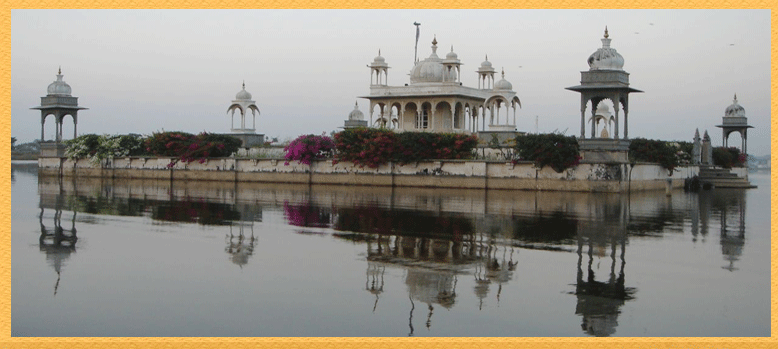What strikes any visitor driving through Dungarpur is its varied topography. Nestled in the Foothills of the Aravallis, the rugged terrain of the north east merges into fertile plains of alluvial soil in the south-west. The Mahi and Som rivers meander through the district, the Mahi separating it from Banswara and the Som drawing a natural boundary between the district and Udaipur. In this topographical diversity a variety of wildlife roam free amongst the flora of teak, mahua, mango and date trees. Jackals, Jungle cats, Indian foxes, hyenas, black faced monkeys, porcupine, the common mongoose co-exist peacefully in this landscape. Spanning across the blue skies are partridges, peafowls, quails, cuckoos, eagles and vultures. Their migratory cousins from across-continents pay their annual visit every winter
Dungarpur, famous for its unique style of architecture was founded in 1282 A.D. by Rawal Veer Singh, when he drove out the Bhil Chieftain Dungaria. What stands steadfast from times past are magnificent palaces and residences of the nobles, adorned by 'Jharokhhas' built in stone. The architectural style was developed during the reign of Maharawal Shiv Singh (1730 - 1785 A.D.). Dungarpur is also known for its gold and silversmiths renowned for lacquer painted toys and picture frames.
Udai Bilas Palace: The royal residence named after Maharawal Udai Singh II, a patron of art & architecture, the palace is a veritable example of the Rajput architecture ornate with intricately Sculptured pillars and panels, impressive balconies, bracketed windows and marvellous arches. It is a running Heritage Hotel.
Juna Mahal: The 13th century seven storeyed structure resembling a fortress with crenellated walls, turrets, narrow entrances and corridors to slow down the enemy. The splendid interiors embellished with beautiful frescoes, miniature paintings and glass and mirror work, make it an impressive creation. One requires prior permission of the resident royal family to visit the palace.
Gaib Sagar Lake: A famous shrine of Shrinathji lies along the lake. The shrine is a Conglomeration of several exquisitely built temples with one main temple. The Vijay Raj Rajeshwar Temple, dedicated to Lord Shiva is an architectural splendour and a fine example of Craftsmanship of the shilpis of Dungarpur.
Government Archaeological Museum: The museum houses a fine collection of ancient statues.
Excursions:-
Beneshwar (60 kms): At the confluence of the Som, Jakham & Mahi rivers, stands the Beneshwar Temple with a Shiva lingam. Nearby is the Vishnu temple, believed to be built at the spot where Mavji, an incarnation of Lord Krishna, meditated. Another noteworthy temple is the Brahma temple- a spacious two storeyed structure with exquisitely carved pillars and gateways. The temple is the venue of an annual fair.
Deo Somnath (24 kms): A splendid 12th century temple of Lord Shiva built in white stone, the temple has imposing turrets. The brilliant juxtaposition of huge stone slabs to create this impressive edifice epitomizes the craftsmanship of the ancient time
Galiyakot (58 kms): Once the capital of Parmars, this tiny village is renowned for its magnificent shrine of Galiyakot Dargah Sayyed Faqruddin. Thousands of devotees throng here during the Urs. The shrine is beautifully decorated and illuminated for the occasion. The Jain temples close by are also worth a visit
Baroda (41 kms): An erstwhile capital of Vagad, the village has some beautiful temples. Of particular note are the old Shiva temple in white stone and an ancient Jain temple whose black wall has exquisitely carved image of the 24 Tirthankaras.
Bhuvaneshwar (9 kms): A famous temple of Lord Shiva is situated here and is the venue of a colorful fair held on the fifth day after Holi. Gair dance by the Bhils is the major highlight of the fair.
TRAVEL INFORMATION
HOW TO REACH DUNGARPUR
Air: Nearest Airport is in Udaipur (120 kms), and Ahmedabad Airport is just 175 kms away.
Rail: It is connected to Udaipur and Ahmedabad. The Railway station is 3 kms from the city. Some important train connections are: 9643 Express (Himmatnagar-Dungarpur-Udaipur); Mewar Pass. (Himmatnagar-Dungarpur-Udaipur)
Road: National Highway No.8 which runs between Delhi and Bombay passes through the district for a total distance of 31 kms. The State Highway passes through the district viz. Sirohi Ratlam highway.
GENERAL INFORMATION
Area: 3780 sq. km.
Climate: Mean Max. Mean Min.
Summer: 43.0 °C 26°C
Winter: 25°C 9°C
Rainfall: 47-76 cms.
Best Season: October - February
Clothing: Summer: Light Tropical
Winter: Light Woollen
Languages: Hindi, English & Raiasthani.



